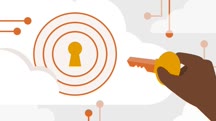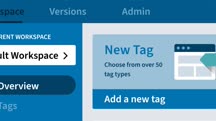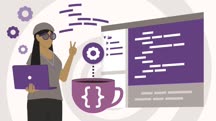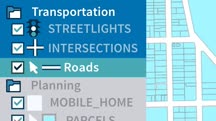Course catalog
Categories
Showing 801-820 of 1,450 items.
Learning Google Cloud Security (232965)
If you’re new to cloud security, or if you’re an administrator looking to learn about best practices to create and manage data and assets in the cloud, join Dominique West in this course as she teaches the basics of properly securing your Google Cloud environment. Dominique starts with the basics of cloud computing and general security concepts, explaining the different services and terminologies as they relate to the Google Cloud platform. She covers topics like Identity and Access Management (IAM), infrastructure security, network security, and details the Google Cloud Security Command Center. By the end of this course, you’ll be well on your way toward becoming a cloud security guru.
Learning Google Cloud Storage (232982)
Google Cloud remains in the top three cloud platforms, and storage remains a high priority for individuals and businesses. In this course, instructor Mark Johnson covers the fundamentals of storage on the Google Cloud platform (GCP). Mark begins with an overview of object storage on GCP. He dives into both relational and non-relational databases, with useful explanations and demos. During the course, Mark addresses GCP services like Firestore, Bigtable, and Cloud Spanner. He wraps up with an introduction to data warehousing and analytics.
Learning Google Tag Manager (229395)
Google Tag Manager is a hugely popular technology that allows marketers to easily manage all their website and app tags from one central tool. This, in turn, frees marketers from their dependency on IT or web development departments—when they want to add or alter a snippet of analytics or tracking code, they can do it themselves by adding it to the existing tag container. This course shows marketers how to effectively leverage Google Tag Manager. Discover how to best work with accounts and containers, leverage the Google Analytics built-in tags, work with control versions and user access, create custom variables and JavaScript, fire Google Analytics events using triggers, and more. Plus, discover crucial time-saving best practices that will help you avoid many common mistakes.
Learning GraphQL (219008)
Data-driven applications depend on remote queries that run through APIs. GraphQL—a query language for APIs that was originally built by Facebook—allows developers to choose the kinds of requests they want to make and to receive information on multiple facets of that query in one request. The GraphQL approach to querying across networks can address a wide variety of large-scale development problems.
In this course, learn how to get started with GraphQL. Eve Porcello introduces the basics of this query language, then walks through queries, variables, and operation names. Eve explains how to work with mutations and subscriptions, as well as how to create and enhance schema. She covers topics like creating a custom object, adding an enumeration type, writing schema documentation, and much more.
Note: This course was created by Moon Highway. We are pleased to host this training in our library.
In this course, learn how to get started with GraphQL. Eve Porcello introduces the basics of this query language, then walks through queries, variables, and operation names. Eve explains how to work with mutations and subscriptions, as well as how to create and enhance schema. She covers topics like creating a custom object, adding an enumeration type, writing schema documentation, and much more.
Note: This course was created by Moon Highway. We are pleased to host this training in our library.
Learning Grasshopper (224040)
Grasshopper offers new ways to expand and control the 3D design and modeling processes. These ways include automating repetitive processes; generating geometry through mathematical functions; quickly making changes to complex models; and creating complex forms through repetitions of simple geometry. Grasshopper requires no programming or scripting knowledge and allows designers a high degree of flexibility. In this course, instructor Chris Reilly shows you how to get up and running with Grasshopper, fast. Chris explains the algorithms that you need to get the most out of Grasshopper and walks you through the Grasshopper interface. Chris covers how to speed up your workflow with shortcuts in Grasshopper. He goes into data matching, Fibonacci sequences, vectors, and many more math and logic functions. Chris discusses curves, surfaces, transformations, data trees, and so much more. He concludes with a series of example projects that illustrate what you’ve learned in the course.
Learning Groovy (221660)
Groovy—a powerful, easy-to-use, and widely adopted language on the Java Virtual Machine (JVM) platform—has found its way into ecosystems like Jenkins Pipelines and Gradle, as well as web development frameworks such as Grails and Micronaut. In this course, learn the basics of working with Groovy. Instructor Benjamin Muschko goes over fundamental concepts such as variables and data types, classes, and exception handling. Along the way, Benjamin establishes the connection between Java and Groovy and highlights where Groovy really shines. He also digs into more advanced concepts, including using closures, working with collections, and reading and writing files. After wrapping up this course, you'll have the basic knowledge you need to run Groovy as a script or full-fledged program.
Learning Illustrator on the iPad (223326)
It’s no surprise that Adobe released Illustrator—the leading vector graphics editor and design program—on the most popular tablet device in the world, the iPad. And while you may be an old hand at Illustrator on the desktop, Illustrator on the iPad is a significantly different experience, with a whole new interface and the option to use the Apple Pencil. If you’re looking to take your logo creations, illustrations, and graphics work from your desktop or laptop to the tablet, join Tony Harmer in this course as he gets you up and running on Illustrator on the iPad. Tony starts with hardware requirements and other basics like choosing colors and creating text. He also shares tips for using standard Illustrator tools, like how to draw with the pencil, create shapes, and use the pen tool. Tony also covers key differences from the desktop and iPad versions of Illustrator, including unsupported content from Illustrator on the desktop and how it is resolved on the iPad.
Learning Infographic Design (222510)
To create a truly successful infographic, you must understand the power of visual communication. Properly executed visuals can connect with an audience faster than any other form of communication. In this course, Amy Balliett, CEO and Founder of Killer Visual Strategies, shows you how to create engaging and successful infographics that stand out from the crowd. Amy shows you how to dissect a bad infographic, to learn what not to do. She shows you how visual communication shines through, even in infographics that aren’t in your native language, then goes over how to leverage visual cues and hooks. Amy introduces the five Ws that you need to identify when designing your infographic and explains why it’s so important to research before design even starts. She walks you through each step of wireframing your infographic and concludes with putting the full design together in Adobe Illustrator.
Note: This course was created by Killer Visual Strategies, a Material Company. We are pleased to host this training in our library.
Note: This course was created by Killer Visual Strategies, a Material Company. We are pleased to host this training in our library.
Learning Infographic Design (2015) (225400)
Over 10,000 infographics are released online everyday, but less than 1% see any real success. To create a successful infographic, you can't combine any text and imagery and call it a day. Infographics aren't just eye candy! It's when designers truly understand the power of visual communication that their infographics break through. Using a few basic design guidelines, they can illustrate big problems in clear language, distill complex ideas, and call attention to overlooked issues.
In this course, Amy Balliett, CEO of Killer Infographics, shows members how to create engaging and successful infographics that will stand out from the crowd. She explains the science behind good visual communication, reviews the different types of infographics, and introduces design principles and techniques that will help you build engaging and successful infographics.
In this course, Amy Balliett, CEO of Killer Infographics, shows members how to create engaging and successful infographics that will stand out from the crowd. She explains the science behind good visual communication, reviews the different types of infographics, and introduces design principles and techniques that will help you build engaging and successful infographics.
Learning Instagram (227950)
Get up and running quickly with Instagram, the popular photo-sharing social network. LinkedIn Learning staff instructor Garrick Chow begins by showing how to find and follow users and take and post photos. Garrick demonstrates how to use the many Instagram filters, as well as add captions and hashtags to your posts. He offers tips for building your network and developing a community of followers. You can also learn how to build reels and Instagram stories—a sequence of photos and videos that expire after a day—and interact with other users through mentions, comments, sharing, and direct messages.
Learning Java Collections (232370)
As developers advance past the basics of Java, they must understand how to effectively use Java collections in their daily work. This course offers you a deep dive into the framework and hands-on experience working with it. The Java Collections framework consists of interfaces, implementations, and utilities that together provide standard support for common data structures in the language. Instructor Kevin Bowersox explains these things, then goes into real examples of techniques for working with them, like creating different collections types and iterating them. He covers operations and interfaces such as List (including both ArrayList and LinkedList), Queue, Deque, and Map. Kevin concludes with a discussion of how you can use Java Collections utilities to sort elements, search collections, use comparators, and more.
Learning JavaScript Animations with GreenSock (218073)
If you're building animations for the web, odds are good you're at least a little familiar with GreenSock. The Greensock JavaScript animation library provides a wide variety of tools and controls for creating animation on the web. While CSS animations allow you to make simple transformations and toggle the state of UI elements in an application, with JavaScript you can create complex animations and advanced effects, control the timing of animations, and control when animations occur. In this course, Christina Gorton gets you started with JavaScript animations, showing you how to work with SVGs, animate them with GreenSock, and create a portfolio page complete with JavaScript animations on scroll.
Learning Lego Mindstorms (87496)
Love LEGOs? The next generation is ready to play. LEGO Mindstorms is a robotics kit designed for all experimenters—not just kids. Its advanced programming capabilities and robust hardware—sensors, motors, and intelligent EV3 brick—make LEGO Mindstorms a fun and challenging microcomputer system for programmers and tinkerers of any age. In this course, Olivia Chiu helps you "open the box" and build your first functional robot with LEGO Mindstorms.
Learn how to unpack the hardware, connect to the programming interface, run prebuilt programs, and control the motors and sensors. Chapter 6, "Adding Flow to a Program," covers advanced programming topics such as transferring data between blocks, using variables to store temporary data, programming conditional logic, and looping actions to run again and again. By the end of the course, you'll have the skills to bring your own robotic creations to life.
Learn how to unpack the hardware, connect to the programming interface, run prebuilt programs, and control the motors and sensors. Chapter 6, "Adding Flow to a Program," covers advanced programming topics such as transferring data between blocks, using variables to store temporary data, programming conditional logic, and looping actions to run again and again. By the end of the course, you'll have the skills to bring your own robotic creations to life.
Learning LinkedIn (214214)
By harnessing the power of the LinkedIn platform, you can tap into an expansive network of professionals, companies, and groups in your industry and beyond. In this course, discover how to make the most of your LinkedIn account. Follow Oliver Schinkten as he explains how to build a stellar LinkedIn profile, and shares how to expand your network, look for new career opportunities, join groups, share updates, and contribute your own thought leadership. He goes over how to use Creator Mode and Cover Story, as well as how to add your preferred pronouns to your LinkedIn profile. Plus, Oliver explores privacy settings and account types. Upon wrapping up this course, you'll have the tools you need to grow your career by leveraging LinkedIn.
Learning LinkedIn for Students (209845)
Learn how to tap into the power of LinkedIn to build a professional network, establish your digital footprint, stay up-to-date in your industry, and much more. In this course, instructor Oliver Schinkten shows how to build a stellar LinkedIn profile, whether or not you have previous work experience. Oliver explains how a LinkedIn profile allows you to provide a more in-depth look at your personal brand and accomplishments than a resume does. He covers how to set up a new LinkedIn account and create a strong profile that grabs attention for all the right reasons, then offers tips for building and expanding your LinkedIn network, identifying job opportunities, connecting with recruiters, and building a professional brand.
Learning LinkedIn Recruiter (210525)
Find the candidates you need with LinkedIn Recruiter, the industry-leading recruiting tool. LinkedIn Recruiter is used by hiring managers, HR teams, and staffing recruiters to find the right people for the right jobs. Watch this course to learn how to fully utilize Recruiter to search for, organize, and contact candidates. LinkedIn Learning staff instructor Oliver Schinkten shows how to create projects and efficiently search for talent in Recruiter, including how to save custom filters and find people who share similar traits with an existing candidate or employee. He also demonstrates how to leverage tools for managing your pipeline and communicating with your team. Plus, find out how to post a job and evaluate the performance of your recruiting efforts with reports.
Learning Local SEO (231690)
Do you need to increase visibility for your business? In this course, instructor Sherry Bonelli shows you how to achieve higher local visibility. Sherry explains the difference between local SEO (search engine optimization) and general SEO and teaches you the local SEO strategies that have the most impact on local search results. She teaches you about how to target keywords and how to leverage Google My Business (GMB) for higher search rankings. Sherry shows you how you can get and manage reviews for higher rankings, create a website that’s friendly to searches as well as users, and build greater trust for your website and brand. While Sherry references Google throughout this course, you can leverage her tips to increase your visibility, no matter the search engine your customers use.
Learning Local SEO [2021] (210933)
Do you need to increase visibility for your business? In this course, instructor Sherry Bonelli shows you how to achieve higher local visibility. Sherry explains the difference between local SEO (search engine optimization) and general SEO and teaches you the local SEO strategies that have the most impact on local search results. She teaches you about how to target keywords and how to leverage Google My Business (GMB) for higher search rankings. Sherry shows you how you can get and manage reviews for higher rankings, create a website that’s friendly to searches as well as users, and build greater trust for your website and brand. While Sherry references Google throughout this course, you can leverage her tips to increase your visibility, no matter the search engine your customers use.
Learning Loom (225587)
Learn how to save time and communicate effectively with Loom, the new video messaging tool used by companies large and small. Follow along with Garrick Chow as he shows how to communicate and save time with Loom. Garrick begins by showing how to set up Loom on your desktop or mobile device. Next, he explains how to adjust settings so that Loom is tailored to your work style, including handy keyboard shortcuts. Garrick walks through how to record messages, whether pure video or a mix of video and screen recording. He also shows how to adjust your videos with the built-in drawing tools and editing features in Loom. Finally, Garrick demonstrates how to share videos 1:1, distribute your videos to a team, or publish them online.
Learning MapGuide Open Source (223377)
MapGuide Open Source is a free, web-based platform for creating and publishing web-mapping applications and geospatial web services. In this course, Gordon Luckett shows how to get up and running with MapGuide and create your own maps. Gordon explains how to install and configure MapGuide, load data in a range of formats and sources, and create stylish layers and combine them into maps. He also details the process for publishing your map to the web, including tips for navigating firewalls, and how to create short URLs for easier user access.

















![Learning Local SEO [2021]](/pluginfile.php/41183/course/overviewfiles/index.jpg)

